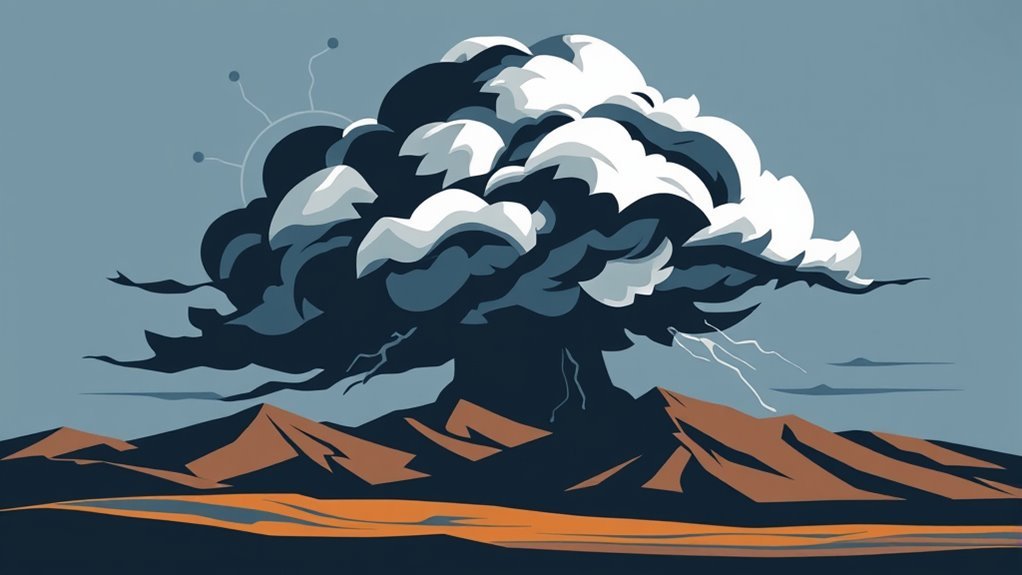Certain regions experience more squalls due to geographical features and climate. Mountainous areas encourage orographic lifting, enhancing squall intensity. Coastal regions see interactions between warm and cold air masses, leading to frequent storms. Additionally, climatic patterns, like El Niño, can alter squall occurrences. Seasonal changes further influence squall frequency, especially in temperate zones. Human activities, including urbanization, also play a role in modifying local weather patterns, leading to an increase in squall formation in specific areas. Continued exploration reveals more understandings into these influences.
Main Points
- Geographic features, like mountains, create lifting mechanisms that enhance squall formation through orographic lifting and localized disturbances.
- Coastal regions experience squalls due to interactions between warm and cold air masses influenced by ocean temperatures.
- Tropical climates, characterized by warm, moist air, lead to more frequent and intense squalls compared to arid regions with limited moisture.
- Seasonal variations affect squall frequency, with contrasting air masses in colder months causing more squall events in temperate zones.
- Human activities, such as urbanization and deforestation, disrupt natural weather patterns, contributing to increased squall intensity and frequency in certain areas.
The Role of Geography in Squall Formation
Although squalls can occur in various climates, their formation is notably influenced by geographical features. Topography plays a vital role, as mountainous regions can create lifting mechanisms that lead to rapid air movement and subsequent squall development.
When moist air is forced upward over raised terrain, it cools and condenses, often resulting in intense precipitation and gusty winds characteristic of squalls.
Additionally, the presence of nearby bodies of water can greatly affect local weather patterns. Coastal regions may experience squalls more frequently due to the interaction between warm and cold air masses. This dynamic can create instability, triggering sudden storms.
Urban areas, with their heat islands, may also contribute to localized squall activity by altering wind patterns. Therefore, the interplay of diverse geographical elements determines the frequency and intensity of squalls in different regions, highlighting the importance of geography in weather phenomena.
Coastal Areas and Oceanic Influences

Coastal areas are greatly influenced by ocean temperature variability, which can affect local weather patterns and the formation of squalls.
The unique geography of coastlines also plays an important role in shaping these weather events, as land and sea interactions create distinct atmospheric conditions.
Understanding these factors is vital for predicting squall activity in coastal regions.
Ocean Temperature Variability
Understanding ocean temperature variability is essential, as it directly influences weather patterns and marine ecosystems in coastal areas. Variations in sea surface temperatures can lead to notable changes in atmospheric conditions. Warmer waters tend to improve evaporation rates, contributing to increased moisture in the air, which can result in more intense squalls.
Conversely, cooler ocean temperatures can stabilize the atmosphere, suppressing storm formation. These temperature fluctuations are influenced by various factors, including ocean currents, seasonal changes, and climate phenomena such as El Niño and La Niña.
Coastal regions are particularly sensitive to these changes, as they experience unique interactions between oceanic and atmospheric conditions, fundamentally affecting local weather and marine biodiversity. Understanding these dynamics is vital for predicting squall occurrences.
Coastal Geography Impact
The interplay between coastal geography and oceanic influences considerably shapes the weather patterns experienced in these regions. Coastal areas often serve as changeover zones where land and sea interact, leading to unique climatic conditions.
The presence of features such as cliffs, bays, and estuaries can promote localized weather phenomena, including squalls. Additionally, ocean currents, driven by temperature and salinity variations, impact air masses that move inland, affecting precipitation and storm development.
Regions adjacent to warm ocean waters are particularly susceptible to increased squall activity due to the higher humidity and energy available for storm formation. Consequently, the specific topography and proximity to the ocean play vital roles in determining the frequency and intensity of squalls in coastal areas.
Mountainous Regions and Topographical Effects
Mountainous regions create unique meteorological conditions that greatly influence the formation and intensity of squalls. The complex topography can improve atmospheric instability, leading to sudden weather changes. Several factors contribute to this phenomenon:
- Orographic Lifting: As moist air ascends the mountains, it cools and condenses, forming clouds and precipitation that can trigger squalls.
- Wind Patterns: The alteration of wind flow over mountains can create turbulence, causing localized disturbances that amplify storm systems.
- Temperature Variations: The elevation differences in mountainous areas result in notable temperature gradients, which can further exacerbate squall conditions.
These interactions between topography and meteorology highlight why mountainous regions often experience more frequent and intense squalls compared to flatter terrains.
Understanding these dynamics is essential for predicting weather events in these areas, thereby improving preparedness and safety measures for residents and travelers alike.
Climate Patterns and Their Impact on Squalls

Climate patterns play a notable role in shaping the occurrence and intensity of squalls across various regions. Regions defined by warm, moist air masses, such as those influenced by tropical climates, often experience more frequent and intense squalls. The presence of warm sea surfaces can improve convection, leading to rapid storm development.
Conversely, arid or semi-arid regions may see fewer squalls due to limited moisture availability, which inhibits cloud formation and precipitation.
In addition, the interplay between high and low-pressure systems greatly influences squall patterns. For instance, areas affected by persistent low-pressure systems can experience more turbulent weather, resulting in increased squall activity.
Moreover, climate phenomena like El Niño or La Niña can alter atmospheric conditions, shifting typical squall occurrences. Understanding these climate patterns is essential for predicting where and when squalls are likely to emerge, thereby aiding in preparedness and response efforts in vulnerable regions.
Seasonal Variations and Squall Frequency

Seasonal variations greatly influence squall frequency, with geographic factors playing an essential role.
Temperature fluctuations and humidity levels can create the ideal conditions for squalls to develop, varying from region to region.
Understanding these dynamics is vital for predicting squall occurrences and their potential impacts.
Geographic Influences on Weather
Although various geographical features play an essential role in shaping weather patterns, the frequency and intensity of squalls are greatly influenced by regional characteristics.
These characteristics can be categorized into three main factors:
- Topography: Mountain ranges can block or redirect air currents, leading to localized weather events, including squalls.
- Proximity to Water Bodies: Areas near oceans or large lakes often experience more squalls due to the moisture and heat that influence atmospheric conditions.
- Latitude: Regions closer to the poles tend to experience different seasonal weather patterns, affecting squall occurrences and intensity.
Understanding these geographic influences is vital for predicting squall activity, as they interact with other meteorological elements to create unique weather phenomena in various regions.
Temperature Fluctuations and Patterns
As temperatures fluctuate throughout the year, the frequency and intensity of squalls can vary markedly across different regions.
Seasonal variations play a significant role in determining when squalls are most likely to occur. In temperate zones, colder months may bring more frequent squalls due to contrasting air masses, while warmer periods can lead to increased instability in the atmosphere.
Conversely, tropical regions may experience squalls year-round, although their intensity might peak during specific seasons, such as during monsoon periods.
Additionally, regions bordering large bodies of water may experience unique temperature patterns that influence squall development.
Understanding these temperature fluctuations helps meteorologists predict squall activity and provides revelations into regional weather phenomena.
Humidity Levels and Impact
While humidity levels considerably influence squall formation, their impact can vary with the seasons. In regions where humidity is consistently high, squalls are more frequent during warmer months when the atmosphere can hold more moisture. Conversely, lower humidity levels during colder months result in reduced squall activity.
The following factors highlight this seasonal variation:
- Warm months: Increased evaporation leads to a greater supply of moisture, heightening squall likelihood.
- Cold months: Drier air prevails, diminishing the potential for squall formation.
- Transitional seasons: Spring and fall can experience fluctuating humidity, causing sporadic squall events.
Understanding these seasonal dynamics provides insight into why certain regions experience varying squall frequencies throughout the year.
Human Activity and Altered Weather Patterns
Human activities, particularly those related to industrialization and urbanization, have greatly influenced weather patterns across the globe. The rise in greenhouse gas emissions from factories, vehicles, and energy production has led to an increase in global temperatures, which in turn affects local climates.
Urban areas often experience the urban heat island effect, where concrete and asphalt absorb and retain heat, creating localized temperature increases. This alteration in temperature can disrupt natural weather patterns, leading to more intense and frequent squalls.
Additionally, deforestation and land use changes contribute to shifts in humidity levels and atmospheric circulation. These changes can improve the likelihood of squall formation in certain regions, as altered land surfaces affect moisture availability.
Consequently, the interplay between human activity and weather patterns highlights the complexity of squalls, with anthropogenic factors playing a crucial role in their occurrence and intensity across different regions.
Case Studies of Regions With High Squall Activity
The impact of human activities on weather patterns sets the stage for examining regions particularly prone to squalls. Various factors contribute to the heightened squall activity in certain areas, including geographical features and climatic conditions.
Notable case studies illustrate these dynamics:
- The Great Lakes Region: Here, the interaction between cold air from the north and warmer lake waters often generates intense squalls, particularly in winter months.
- Southeastern United States: The confluence of moist air from the Gulf of Mexico and cooler air from the Appalachians creates ideal conditions for frequent squall lines, especially during spring.
- East Coast of Australia: Coastal topography and trade winds lead to sudden squall formations, impacting local weather patterns and marine activities.
These case studies highlight how natural and anthropogenic factors connect, resulting in increased squall occurrences in these regions.
Understanding these dynamics is essential for effective weather forecasting and mitigation strategies.
Common Questions
How Do Squalls Differ From Thunderstorms?
Squalls are sudden, intense windstorms often accompanied by rain, differing from thunderstorms, which involve lightning and thunder. Squalls typically occur over water or coastal areas, while thunderstorms can develop in various atmospheric conditions.
Can Squalls Occur in Desert Regions?
Squalls can indeed occur in desert regions, although infrequently. These sudden disturbances may arise from localized atmospheric conditions, leading to brief yet intense winds and precipitation, contrasting with the typically dry and stable climate of deserts.
What Safety Measures Should Be Taken During a Squall?
During a squall, individuals should seek shelter indoors, avoid windows, and secure loose objects. Staying informed through weather alerts and having an emergency kit prepared can improve safety and preparedness against sudden severe weather conditions.
Are Squalls Predictable Using Weather Technology?
Squalls can be partially predicted using advanced weather technology, including radar and satellite imagery. These tools help meteorologists identify developing storm systems, but the sudden nature of squalls presents challenges for accurate forecasting in real-time situations.
Do Squalls Typically Cause Damage to Infrastructure?
Squalls often lead to considerable damage to infrastructure, including downed power lines, destroyed trees, and damaged homes. The intensity and suddenness of these storms can overwhelm local systems, resulting in costly repairs and disruptions.

